International Brotherhood of Electrical Workers (IBEW) workers in Boulder City, Nevada, gave Secretary of Energy Jennifer M. Granholm and Congresswoman Susie Lee (D-NV) a demonstration of how solar panels are installed during a private tour of a Nevada construction site. The Energy Secretary and Congresswoman toured Arevon’s Townsite Solar Facility in Boulder City on June 11, 2021, to meet workers and promote opportunities in clean energy jobs.
Arevon, North America’s leading renewable energy company, is developing the 232-MWDC/193.95-MWAC solar PV plant south of Las Vegas with Rosendin’s Renewable Energy Group, a true EPC that provides renewable energy design planning, construction and maintenance, for solar and wind energy projects. Company leaders met with Granholm and Lee to explain the project, while IBEW workers demonstrated techniques and described what these jobs mean to them.
“This solar plant is the perfect example of how we can use the potential in clean energy to create good-paying union jobs that grow the economy, reduce energy bills and address climate change,” said Energy Secretary Jennifer M. Granholm. “President Biden’s American Jobs Plan will create millions of clean energy jobs all across the supply chain that will be needed to plan facilities, manufacture materials, install transmission lines and solar panels, and it’s going to help us get our country get to 100% clean electricity by 2035.”
Townsite Solar Facility currently supports 480 construction trade jobs. Since November, IBEW Local 357 workers contributed over 147,800 labor hours through May 2021, with the peak manpower of 520 craft workers. The IBEW has been critical to the success of the project by providing a steady stream of reliable, qualified craft workers.
“As the operator of one of the largest solar portfolios in the country, Arevon is proud of its contribution to Nevada’s clean energy economy,” said Justin Johnson, CEO of Arevon. “At Townsite and beyond, we’ve created thousands of jobs building solar and storage power plants across the country. We appreciate everyone who’s worked on constructing Townsite and we look forward to completing this project by the end of the year.”
The 1,053-acre Townsite project incorporates 528,084 First Solar’s Series 6 PV modules on a NEXTracker Horizontal Single Axis Tracking System and uses Sungrow inverters. Upon completion, the Townsite Solar Facility will be co-located with one of the largest battery energy storage systems (BESS) built to date. Power generated on-site will be distributed underground to a 230-kV substation and overhead generation tie line to the Mead Substation just outside Boulder City.
“The City of Boulder City has always been ahead of the curve when it comes to alternative, renewable energy; it comes from our roots. Hoover Dam generates of 4.5 billion kilowatt-hours annually, keeping power supplied to some eight million people in Arizona, California and Southern Nevada,” said Mayor Kiernan McManus. “Here we are, 85 years after Hoover Dam opened, leading the charge in renewable energy. It’s a source of pride for Boulder City and all of Southern Nevada.”
News item from Arevon

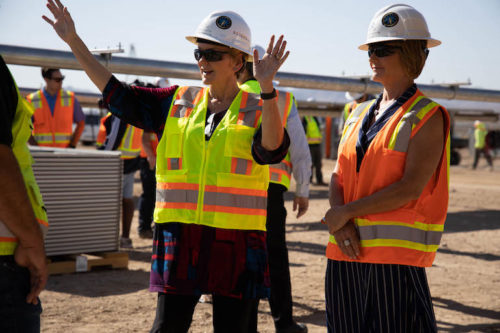
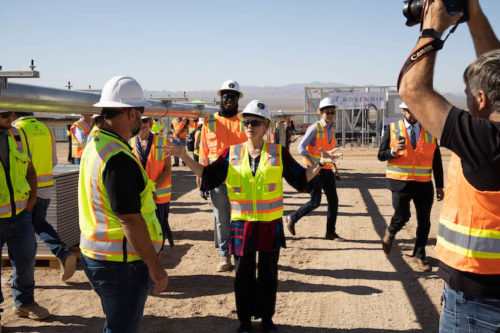
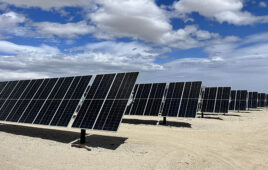
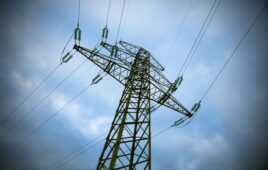
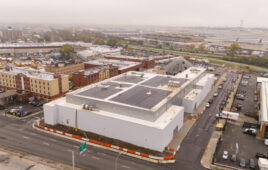
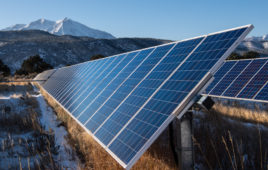
Morning,
All good and nice with these power projects. However, these are all temporary jobs that will go away as soon as the projects dry out due to no more land to construct these projects or any other reason. The jobs only last a couple of months and only have 4 – 10 permanent jobs depending on the size (one person per every 100MW). I believe the true solution for steady jobs is implementing solar technology in every single home in the US. Sometimes people think they can build solar and wind farms everywhere, and they do not think about the environmental impact they cause.
The very business model of the electric utilities of centralized generation with power corridor transmission lines shipping power to customers along the way. Every time a transformer is placed along the grid to step up or step down voltages, one loses about 3% of the power at each transformer step. Solar PV, Wind generation and even energy storage is the (most) efficient when installed where the energy will be used.
Electricity distribution along the grid can lose from 12% of the power up to 25% of the power getting electricity to rural ratepayers. The ratepayers will always be expected to absorb all inefficiency costs in the retail rates per kWh of energy use each month. For the last 16 years I have been using ‘simple’ grid tied solar PV systems and have found with the savings in electricity each month one will pay of their systems, usually 15 years or I believe from now on 10 years or less. While not spending money every month on electricity, one can use the yearly savings and pay for their homeowner’s insurance for the year. Perhaps even have some money left over to help pay property taxes or buy groceries or put money towards buying new Energy Star appliances. What I have found over the years is every time one replaces an old appliance, such as the air conditioning unit(s) with the latest/greatest technology, your energy budget gets ‘smaller’, you get more energy credits and your system pays for itself in energy savings sooner. When the utility increases rates per kWh, you have more credits and are operating your home energy needs more efficiently. It’s all money back into your household budget. Oversize your solar PV array up front and when you get a BEV, put money back into your household budget by not buying gasoline.
“”Hoover Dam generates of 4.5 billion kilowatt-hours annually, keeping power supplied to some eight million people in Arizona, California and Southern Nevada,” said Mayor Kiernan McManus. “Here we are, 85 years after Hoover Dam opened, leading the charge in renewable energy. It’s a source of pride for Boulder City and all of Southern Nevada.””
Might want to check that ‘pride’ just a little bit. IF it’s true that Hoover Dam generates 4.5 billion kilowatt-hours annually, this project with 232MWp with single axis tracking in a desert installation, can make some 8 hours of energy generation during the Winter and up around 12 hours of generation during the summer months. On (average), this site can supply 8 sun hours a day for the year at 1.86GWh a day and 677.4GWh a year, not as ‘large’ as Hoover Dam, but sooner or later water curtailment due to severe drought conditions will also ‘curtail’ the penstocks and generation output from the dam. The bottom line, you can’t drink electricity. One needs about 6 more of these sized projects to take over for the dam. Not unlike California at this time, Las Vegas needs around 50GWh of energy storage to help them get through the summer months that seem to be getting longer each year. At higher elevations and more northern, something like 40 degrees north Latitude there seems to be four seasons still. Down around the 30 to 36 degrees Latitudes, there seems to be only summer and spring anymore.
The sooner the Government(s) wake up, both Federal and State(s), there needs to be a (firm) understanding that some 350 miles of pipelines into the Pacific Ocean are needed to move sea water 350 miles into other dry States or get into the water supply business and desalinate and pump. Right now Nevada needs about 822 acre feet of desalinated water a day. Arizona needs about 7,700 acre feet of desalinated water a day and California needs about 105 million acre feet of desalinated water a day. That’s a whole lot of energy just to get a drink of water. With “mandates” for all electrification of homes and businesses, no more ICE vehicle sales by 2035 and a growing population (nation wide) a drink of water is going to become very expensive. This expansive “energy game” is just beginning.